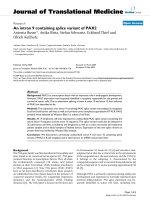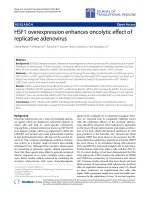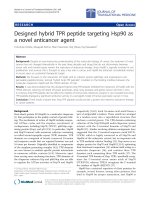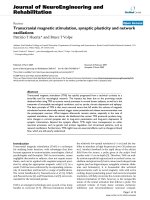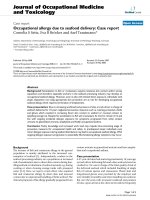Báo cáo hóa học: " Lattice-patterned LC-polymer composites containing various nanoparticles as additives" potx
Bạn đang xem bản rút gọn của tài liệu. Xem và tải ngay bản đầy đủ của tài liệu tại đây (1.14 MB, 16 trang )
This Provisional PDF corresponds to the article as it appeared upon acceptance. Fully formatted
PDF and full text (HTML) versions will be made available soon.
Lattice-patterned LC-polymer composites containing various nanoparticles as
additives
Nanoscale Research Letters 2012, 7:46 doi:10.1186/1556-276X-7-46
Kyoseung Sim ()
Shi-Joon Sung ()
Eun-Ae Jung ()
Dae-Ho Son ()
Dae-Hwan Kim ()
Jin-Kyu Kang ()
Kuk Young Cho ()
ISSN 1556-276X
Article type Nano Express
Submission date 8 September 2011
Acceptance date 5 January 2012
Publication date 5 January 2012
Article URL />This peer-reviewed article was published immediately upon acceptance. It can be downloaded,
printed and distributed freely for any purposes (see copyright notice below).
Articles in Nanoscale Research Letters are listed in PubMed and archived at PubMed Central.
For information about publishing your research in Nanoscale Research Letters go to
/>For information about other SpringerOpen publications go to
Nanoscale Research Letters
© 2012 Sim et al. ; licensee Springer.
This is an open access article distributed under the terms of the Creative Commons Attribution License ( />which permits unrestricted use, distribution, and reproduction in any medium, provided the original work is properly cited.
Lattice-patterned LC-polymer composites containing various nanoparticles as
additives
Kyoseung Sim
1
, Shi-Joon Sung
*1
, Eun-Ae Jung
1
, Dae-Ho Son
1
, Dae-Hwan Kim
1
, Jin-Kyu
Kang
1
, and Kuk Young Cho
2
1
Green Energy Research Division, DGIST, 50-1 Sang-ri, Hyeonpung-myeon, Dalseong-gun,
Daegu, 711-873, Republic of Korea
2
Division of Advanced Materials Engineering, Kongju National University, 275 Budae-dong,
Cheonan, Chungnam, 331-717, Republic of Korea
*Corresponding author:
Email addresses:
KS:
SJS:
EAJ:
DHS:
DHK:
JKK:
KYC:
Abstract
In this study, we show the effect of various nanoparticle additives on phase separation
behavior of a lattice-patterned liquid crystal [LC]-polymer composite system and on interfacial
properties between the LC and polymer. Lattice-patterned LC-polymer composites were
fabricated by exposing to UV light a mixture of a prepolymer, an LC, and SiO
2
nanoparticles
positioned under a patterned photomask. This resulted in the formation of an LC and prepolymer
region through phase separation. We found that the incorporation of SiO
2
nanoparticles
significantly affected the electro-optical properties of the lattice-patterned LC-polymer
composites. This effect is a fundamental characteristic of flexible displays. The electro-optical
properties depend on the size and surface functional groups of the SiO
2
nanoparticles. Compared
with untreated pristine SiO
2
nanoparticles, which adversely affect the performance of LC
molecules surrounded by polymer walls, SiO
2
nanoparticles with surface functional groups were
found to improve the electro-optical properties of the lattice-patterned LC-polymer composites
by increasing the quantity of SiO
2
nanoparticles. The surface functional groups of the SiO
2
nanoparticles were closely related to the distribution of SiO
2
nanoparticles in the LC-polymer
composites, and they influenced the electro-optical properties of the LC molecules. It is clear
from our work that the introduction of nanoparticles into a lattice-patterned LC-polymer
composite provides a method for controlling and improving the composite's electro-optical
properties. This technique can be used to produce flexible substrates for various flexible
electronic devices.
Keywords: phase separation; nanoparticle; LC-polymer composite; photopolymerization; lattice
pattern.
Introduction
Owing to its impact on device performance, the phase separation behavior of materials and its
effect on the device morphology have attracted considerable attention as one of the powerful
methods for fabricating flexible electronic devices, such as organic photovoltaics, organic field
effect transistors, organic nonvolatile memory devices, and liquid crystal displays [LCDs] [1-6].
The phase separation of a mixture is attributed to the difference in surface free energy among the
components and their interactions with each other. Lattice-patterned liquid crystal [LC]-polymer
composites, which are characterized by phase separation of the mixture of LC and the miscible
photoreactive monomers upon UV light irradiation under a patterned mask, are one of the most
important fabrication materials for flexible substrates that can be used in flexible electronics,
owing to their sophisticated and controllable non-contact characteristics [7, 8].
As the region of the mixture that is irradiated by UV light undergoes a photoreaction to form
polymerized polymer walls that act as a supporting structure, the monomer and LC
simultaneously diffuse into polymer-rich and polymer-poor regions, respectively, through
dynamic phase separation. This is the cause of the difference in the surface free energy and the
low miscibility between the LC molecules and the UV-cured polymers. The phase separation can
be used to determine the features of cells containing the LC surrounded by polymer walls. These
structures are resistant to bending stress, satisfying a fundamental requirement of flexible
electronic substrates.
However, as in all organic material systems, the control of physical and electro-optical
properties of LC-polymer composites is limited due to the restricted properties of the organic
materials. Nowadays, in order to overcome the limitations of all organic material systems, many
research groups have become interested in enhancing phase separation using hybrid materials,
which involves introducing inorganic materials into the system. To minimize the deterioration of
the display properties, such as the transparency, it is preferable to use inorganic materials in the
form of nanoparticles as additives [9-13].
In this study, we show the effects of introducing inorganic nanoparticles into lattice-patterned
LC-polymer composites on the phase separation behavior and electro-optical properties of the
composites. Prepolymers containing nanoparticles were prepared by mixing UV-curable
monomers and SiO
2
nanoparticles of varying sizes and with various surface functional groups.
Photoinduced phase separation was caused by exposing the LC-prepolymer mixtures to UV light
by using a lattice-patterned photomask. The phase separation structures of the lattice-patterned
LC-polymer composites were then studied using polarized optical microscope imaging, and the
electro-optical properties of the LC were investigated by measuring the contrast ratio and the
driving voltage of the lattice-patterned LC-polymer composites.
Experimental details
A UV-curable prepolymer solution was prepared by mixing ethylhexyl acrylate [EHA]
(Sigma-Aldrich Corporation, St. Louis, MO, USA; used as a monomer), polyethyleneglycol
diacrylate [PEGDA] (Sigma-Aldrich Corporation, St. Louis, MO, USA; used as a cross-linker),
and Darocur 4285 (Sigma-Aldrich Corporation, St. Louis, MO, USA; used as a photoinitiator);
Figure 1a shows the chemical structures of these compounds. In order to investigate the effects
of particle size and surface functional groups, four different types of SiO
2
nanoparticles were
synthesized. SiO
2
nanoparticles with diameters of 7 and 14 nm that were not subjected to post-
treatment are denoted by SiNP-7 and SiNP-14, respectively. Two different types of
functionalized SiO
2
nanoparticles were prepared using bis[3-(trimethoxysilyl)propyl]amine
[BTMA] and [3-(methacryloyloxy)propyl] trimethoxy silane [MPS] based on silane coupling
reactions, and they were labeled BTMA-SNP and MPS-SNP, respectively (Figure 1b). The
quantities of SiO
2
nanoparticles were 1, 3, and 5 wt.% relative to the weight of the acrylate
prepolymer solutions.
Lattice-patterned LC-polymer composites were prepared by exposing the mixture containing
the prepolymer solution (50 wt.%) and LC (E7, Merck KGaA, Darmstadt, Germany ; 50 wt.%)
to UV light. The LC cell was prepared using two ITO glass slides coated with rubbed polyimide,
between which the LC-prepolymer mixture was injected by capillary effect at 100°C, which was
above the clearing temperature. To form the polymer walls, UV light was radiated for 400 s
through a photomask comprising 300 × 300 µm
2
of dark square patterns with a 30-µm spacing.
The sample temperature was maintained at 100°C. Polarized optical microscope images of the
lattice-patterned LC-polymer composites were obtained, and the polymer wall thickness was
determined by using a microscope system (Eclipse LV100D, Nikon Co., Shinjuku, Tokyo,
Japan). In order to confirm the effect of the various SiO
2
nanoparticles on the electro-optical
properties of the LC, the contrast ratio and the driving voltage of the LC-polymer composites
were measured.
Results and discussion
Figure 2 presents polarized optical microscope images of the lattice-patterned LC-polymer
composites prepared by using mixtures of the LC and UV-curable prepolymers containing
untreated SiO
2
nanoparticles (SiNP-7 and SiNP-14) as an additive. All the images show cells of
LC molecules surrounded by UV-cured polymer walls. From the polarized optical microscope
images, it can be seen that the dependence of the phase separation structure on the quantities of
SiNP-7 and SiNP-14 is small. The polymer wall thickness decreased slightly with an increase in
the quantities of SiNP-7 and SiNP-14. In the cases of the functionalized SiO
2
nanoparticles,
BTMA-SNP and MPS-SNP, the LC-polymer composites also showed a similar phase separation
structure regardless of the quantities of BTMA-SNP and MPS-SNP (Figure 3). However, the
polymer wall thickness did not change with the quantities of BTMA-SNP and MPS-SNP. The
wall thickness reduction in the lattice-patterned LC-polymer composites with an increase in the
quantities of SiNP-7 and SiNP-14 could be interpreted as being due to untreated SiO
2
nanoparticles diffusing in the direction opposite to that of the polymerizing regions [14, 15].
Thus, SiNP-7 and SiNP-14 migrated into the LC domains during photoinduced phase separation,
resulting in a loss of volume for SiNP-7 and SiNP-14 and a loss in their free volume in the
polymeric region. The reduction in the volume of the polymer walls corresponded to an increase
in the quantities of SiNP-7 and SiNP-14, and thus, the polymer wall thickness also decreased.
However, in the case of the functionalized SiO
2
nanoparticles, the presence of alkyl chains gave
the nanoparticles a hydrophobic character, which resulted in the particles being sequestered
within the polymeric region [15]. BTMA-SNP and MPS-SNP were expected to remain in the
polymeric region during photoinduced phase separation, and the volume of the polymer walls
containing BTMA-SNP or MPS-SNP should not have changed with the quantities of BTMA-
SNP and MPS-SNP. Therefore, there was no change in the polymer wall thickness regardless of
the quantity of the surface-treated inorganic nanoparticles. Figure 4 summarizes the changes in
the polymer wall thickness with the size and surface functional groups of the SiO
2
nanoparticles.
As can be clearly seen in the polarized optical microscope images, the polymer wall thickness
decreased with an increase in the quantities of SiNP-7 and SiNP-14, whereas no difference was
observed for the cases of BTMA-SNP and MPS-SNP. Thus, the functional groups of SiO
2
nanoparticles were closely related to the phase separation behavior of the lattice-patterned LC-
polymer composites, and the polymer wall thickness was affected only by the inclusion of
untreated SiO
2
nanoparticles.
In addition to the phase separation behavior of the LC-polymer composites, it is important to
investigate the electro-optical properties of the composites when SiO
2
nanoparticles are included
in the prepolymer systems from the viewpoint of the applications of the composites. To this end,
we measured the contrast ratio and driving voltage of the lattice-patterned LC-polymer
composites. The contrast ratio of the LC is the ratio of light transmittance between the on-state
and the off-state of the LC, and the driving voltage is the intensity of external electric field
required to obtain the contrast ratio of the LC. The contrast ratio and driving voltage are known
to affect the electro-optical properties of conventional LCDs. Figure 5 illustrates the contrast
ratio and driving voltage of the LC-polymer composites containing SiNP-7 or SiNP-14. The
contrast ratio decreased with the quantities of SiNP-7 and SiNP-14, and the range over which the
contrast ratio decreased was more apparent for SiNP-14. When an external electric field was
applied to the composites, the LC molecules rotated. In terms of driving the LC molecules, the
SiO
2
nanoparticles can hinder the movement of LC molecules, and thus, the contrast ratio of the
LC would decrease with an increase in the quantity of SiO
2
nanoparticles. These results also
support the view that the untreated SiO
2
nanoparticles, SiNP-7 and SiNP-14, were mainly
located in the LC regions after photoinduced phase separation. In the case of the driving voltage,
the SiO
2
nanoparticles can have a similar hindrance effect on the movement of the LC molecules,
and thus, the driving voltage of the LC molecules would increase with an increase in the quantity
of SiO
2
nanoparticles. In the case of SiNP-14, SiO
2
nanoparticles with larger diameters can
disturb the movement of the LC molecules more easily than those of SiNP-7, and thus, the
changes in the contrast ratio and driving voltage were more evident than in the case of SiNP-7.
In contrast with the case of untreated SiO
2
nanoparticles, BTMA-SNP and MPS-SNP had
different impacts on the electro-optical properties of the lattice-patterned LC-polymer
composites (Figure 6). In the case of BTMA-SNP, the contrast ratio of the LC increased from 32
to 35, and the driving voltage remained about 11.5 V regardless of the quantity of BTMA-SNP.
The surface of the BTMA-SNP was covered with a hydrophobic BTMA functional group and
thus maintained its location in the polymeric region after photoinduced phase separation. It is
thought that the surface region of the polymer walls may have been affected by the hydrophobic
BTMA-SNP and that the interaction between the LC and the polymer walls could thus have been
weakened by the BTMA-SNP. Owing to the decreased interaction between the LC and the
polymer walls, the movement of the LC molecules upon the application of an external electric
field was less likely to be hindered by the polymer walls, and the electro-optical properties could
have been improved by the inclusion of BTMA-SNP in the prepolymers. However, BTMA-SNP
would aggregate in the polymer walls because the nanoparticle-polymer interactions were
unfavorable with respect to polymer-polymer interactions. The entropy of mixing of the
polymeric and nanoparticle systems is generally quite small, and thus, even small unfavorable
polymer-nanoparticle interactions can lead to nanoparticle aggregation. Therefore, no
improvement in the electro-optical properties of the LC-polymer composites upon the inclusion
of BTMA-SNP was evident.
In the case of MPS-SNP, the positive effect of SiO
2
nanoparticles on the electro-optical
properties was more evident than in the case of BTMA-SNP. The contrast ratio of the LC
increased from 32 to 43, and the driving voltage decreased to about 9.5 V as the quantity of
MPS-SNP increased to 5 wt.%. MPS-SNP nanoparticles were modified by using an MPS
functional group, which had a long alkyl chain and a methacryloyl group, for the
photopolymerization reaction. Similar to BTMA-SNP, MPS-SNP also shows hydrophobic
properties because of its long alkyl chains and is thus expected to remain in the polymeric region
during photoinduced phase separation. However, compared with BTMA-SNP, MPS-SNP has a
photoreactive methacryloyl functional group and can also participate in the photopolymerization
of prepolymers. Therefore, MPS-SNP can be uniformly distributed in the region around the
polymer walls after photoinduced phase separation and can prevent the aggregation of MPS-SNP
in the polymer walls. Owing to the uniform distribution of MPS-SNP in the polymer walls, the
surface region of the walls might have been well covered by MPS-SNP, and thus, the
improvement in the electro-optical properties of the LC-polymer composites was more evident
than it was for BTMA-SNP.
Figure 7 shows a schematic diagram of the distribution of SiO
2
nanoparticles in the lattice-
patterned LC-polymer composites. The starting mixture contained an LC, a prepolymer, and
nanoparticles as additives (Figure 7a). When the LC-prepolymer mixtures with nanoparticles
were irradiated by UV light through a photomask with dark square patterns, polymerization
occurred in the irradiated area. As a result, the mixture was divided into polymer walls (the
polymer region) and cells (the LC region) by photoinduced phase separation between the LC and
the prepolymer. Subsequently, the lattice-patterned LC-polymer composites were formed. If we
had added nanoparticles to the LC-prepolymer mixture system, the position of the nanoparticles
would have changed from the LC region to the polymeric region, depending on the surface
functional groups of the nanoparticles. Because of the hydroxyl group on their surface, the non-
functionalized SiO
2
nanoparticles diffused into the LC region during photoinduced phase
separation and remained in the LC region (Figure 7b). The SiO
2
nanoparticles in the LC regions
might have hindered the movement of the LC molecules, and thus, a change in the distribution of
the nanoparticles from the LC region to the polymeric region was required. On the other hand,
Figure 7c shows the case of functionalized SiO
2
nanoparticles in the prepolymer systems. In this
case, the surface region of the SiO
2
nanoparticles was covered by functional groups, such as
BTMA and MPS. When the alkyl chains were used as a surface functional group, the surface
properties of the SiO
2
nanoparticles could be easily changed from hydrophilic to hydrophobic.
Therefore, the functionalized SiO
2
nanoparticles resided in the polymeric region after
photoinduced phase separation, and they did not affect the LC region. The SiO
2
nanoparticles in
the polymeric region could have also contributed to the interfacial properties between the LC and
the polymer walls. However, the hydrophobic SiO
2
nanoparticles tended to aggregate in the
polymeric region, and thus, the addition of SiO
2
nanoparticles to the prepolymers was less
effective for controlling the interfacial properties of the LC-polymer composites. To prevent the
aggregation of SiO
2
nanoparticles in the polymer walls, a surface functional group that could
participate in photopolymerization would be required. SiO
2
nanoparticles with MPS could
participate in photopolymerization, and the SiO
2
nanoparticles would be uniformly distributed in
the polymer walls. Thus, the effects of SiO
2
nanoparticles with MPS on electro-optical properties
could be greater than those of SiO
2
nanoparticles with BTMA.
Conclusions
We found that phase separation behavior and interfacial properties of lattice-patterned LC-
polymer composites were significantly affected by the inclusion of various SiO
2
nanoparticles in
the prepolymers. The distribution of SiO
2
nanoparticles in the LC-polymer composites was
affected by the surface functional groups of the nanoparticles. Untreated SiO
2
nanoparticles were
mainly located in the LC region, and thus, the behavior of the LC molecules was disturbed by
these nanoparticles. Surface functionalized SiO
2
nanoparticles remained in the polymeric region
after photoinduced phase separation due to the hydrophobic alkyl chains of the surface functional
groups. The SiO
2
nanoparticles in the polymer walls were closely related to the interfacial
properties between the LC and the polymer walls. In particular, SiO
2
nanoparticles with a
photoreactive methacryloyl group could participate in the photopolymerization of the
prepolymers. Owing to the uniform distribution of the SiO
2
nanoparticles with a methacryloyl
group, the electro-optical properties of the LC-polymer composites were effectively improved by
the inclusion of the nanoparticles. By using customized nanoparticles with various sizes and
surface functional groups as additives, it might be possible to control the phase separation
behavior and the interfacial properties of lattice-patterned LC-polymer composite systems. Such
control can facilitate the use of the LC-polymer composite system for the fabrication of various
flexible electronic devices.
Competing interests
The authors declare that they have no competing interests.
Authors' contributions
KS interpreted the experimental results and prepared the manuscript draft and figures. SJS
proposed the main research idea, completed the final manuscript, and presided over the study.
EAJ carried out most of the experiments. DHS operated the experimental instruments used in the
study. DHK and JKK verified the data interpretation. KYC helped in revising the manuscript. All
the authors read and approved the final manuscript.
Acknowledgments
This work was supported by the DGIST R&D Program of the Ministry of Education, Science
and Technology of Korea (11-BD-03).
References
1. Peet J, Heeger AJ, Bazan GC: “Plastic” solar cells: self-assembly of bulk
heterojunction nanomaterials by spontaneous phase separation. Acc Chem Res 2009,
42:1700-1708.
2. Qiu L, Lim J, Wang X, Lee W, Hwang M, Cho K: Versatile use of vertical-phase-
separation-induced bilayer structures in organic thin-film transistors. Adv Mater
2008, 20:1141–1145.
3. McNeill CR, Asadi K, Watts B, Blom PWM, de Leeuw DM: Structure of phase-
separated ferroelectric/semiconducting polymer blends for organic non-volatile
memories. Small 2010, 4:508-512.
4. Bauer M, Hartmann L, Kuschel F, Seiler B, Noack E: Display forming polymer/liquid
crystal composite layers and their stability against external mechanical distortions. J
Appl Polym Sci 2010, 117:1924-1933.
5. Baek W, Yoon T, Lee H, Kim Y: Composition-dependent phase separation of
P3HT:PCBM composites for high performance organic solar cells. Org Electron
2011, 11:933-937.
6. Miller N, Gysel R, Miller CE, Verploegen E, Beiley Z, Heeney M, McCulloch I, Bao Z,
Toney MF, McGehee MD: The phase behavior of a polymer-fullerene bulk
heterojunction system that contains bimolecular crystals. J Polym Sci Part B: Polym
Phys 2011, 49:499-503.
7. Jung JW, Park SK, Kwon SB, Kim JH: Pixel-isolated liquid crystal mode for flexible
display applications. Jpn J Appl Phys 2004, 43:4269-4272.
8. Sung SJ, Jung EA, Kim DH, Son DH, Kang JK, Cho KY: Pixel-isolation liquid crystals
formed by polarization-selective UV-curing of a prepolymer containing cinnamate
oligomer. Opt Express 2010, 18:11737-11745.
9. Sanchez C, Escuti MJ, van Heesch C, Bastiaansen CWM, Broer DJ, Loos J, Nussbaumer
R: TiO
2
nanoparticle-photopolymer composites for volume holographic recording.
Adv Funct Mater 2005, 26:1623-1629.
10. Hindson JC, Saghi Z, Hernandez-Garrido J, Midgley PA, Greenham NC: Morphological
study of nanoparticle-polymer solar cells using high-angle annular dark-field
electron tomography. Nano Lett 2011, 11:904-909.
11. Busbee JD, Juhl AT, Natarajan LV, Tongdilia VP, Bunning TJ, Vaia RA, Braun PV:
SiO
2
nanoparticle sequestration via reactive functionalization in holographic
polymer-dispersed liquid crystals. Adv Mater 2009, 21:3659-3662.
12. Balazs AC, Emrick T, Russell TP: Nanoparticle polymer composites: where two small
worlds meet. Science 2006, 314:1107-1110.
13. Bockstaller MR, Mickiewicz RA, Thomas EL: Block copolymer nanocomposites:
perspectives for tailored functional materials. Adv Mater 2005, 17:1331-1349.
14. Suzuki N, Tomita Y: Silica-nanoparticle-dispersed methacrylate photopolymers with
net diffraction efficiency near 100%. Appl Opt 2004, 43:2125-2129.
15. Vaia RA, Dennis CL, Nataranjan LV, Tondiglia VP, Tonlin DW, Bunning TJ: One-step,
micrometer-scale organization of nano- and mesoparticles using holographic
photopolymerization: a generic technique. Adv Mater 2001, 13:1570-1574.
Figure 1. Chemical structures of the components for prepolymers. (a) EHA, PEGDA, and
Darocur 4265 used for the preparation of prepolymers and (b) functionalized SiO
2
nanoparticles
with BTMA and MPS.
Figure 2. Polarized optical microscope images of lattice-patterned LC-polymer composites
containing non-functionalized SiO
2
nanoparticles as additives.
Figure 3. Polarized optical microscope images of lattice-patterned LC-polymer composites
containing functionalized SiO
2
nanoparticles as additives.
Figure 4. The polymer wall thickness of lattice-patterned LC-polymer composites
containing non-functionalized and functionalized SiO
2
nanoparticles.
Figure 5. Electro-optical properties of lattice-patterned LC-polymer composites containing
non-functionalized SiO
2
nanoparticles as additives. The contrast ratio for a driving voltage of
12.5 V and the driving voltage corresponding to a contrast ratio of 30 in the case of lattice-
patterned LC-polymer composites containing non-functionalized SiO
2
nanoparticles as additives.
Figure 6. Electro-optical properties of lattice-patterned LC-polymer composites containing
functionalized SiO
2
nanoparticles as additives. The contrast ratio for a driving voltage of 12.5
V and the driving voltage corresponding to a contrast ratio of 30 in the case of lattice-patterned
LC-polymer composites containing functionalized SiO
2
nanoparticles as additives.
Figure 7. Schematic diagram of the distribution of SiO
2
nanoparticles in lattice-patterned
LC-polymer composites. (a) The mixture of an LC, a prepolymer, and SiO
2
nanoparticles, (b)
the distribution of non-functionalized SiO
2
nanoparticles, and (c) the distribution of
functionalized SiO
2
nanoparticles after photoinduced phase separation.
Figure 1
0 wt%
SiNP-7_1wt% SiNP-7_3wt% SiNP-7_5wt%
SiNP-14_1wt% SiNP-14_3wt% SiNP-14_5wt%
Figure 2
BTMA-SNP_1wt%
BTMA-SNP_3wt% BTMA-SNP_5wt%
MPS-SNP_1wt%
MPS-SNP_3wt% MPS-SNP_5wt%
0 wt%
Figure 3
Figure 4
Figure 5
Figure 6
LC region
Polymer wall
(a)
(b) (c)
SiO
2
nanoparticle Functionalized SiO
2
nanoparticle
Photo-induced phase separation using photomask
LC and prepolymer
mixture
nanoparticle
Figure 7

